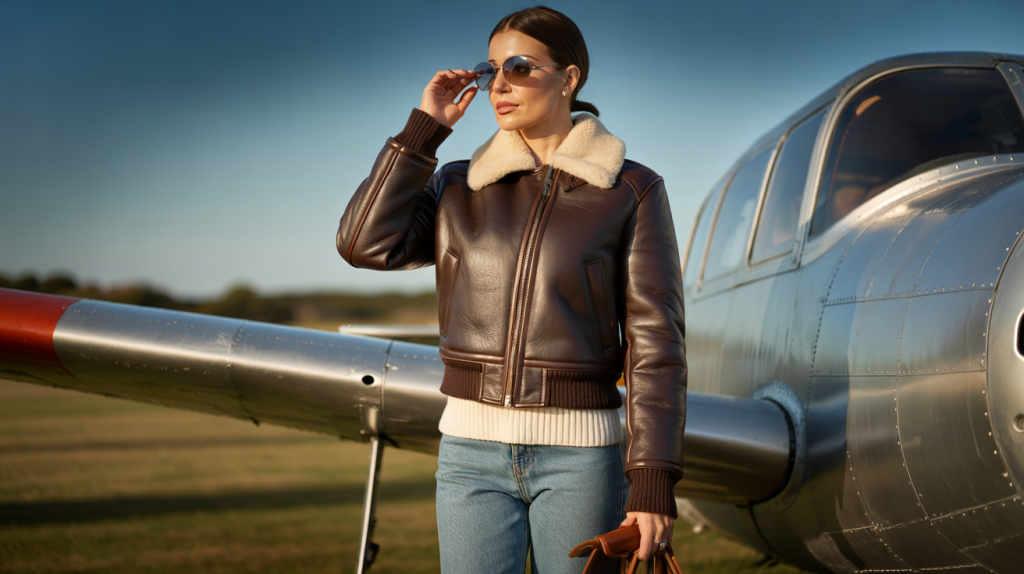The women leather aviator jacket does one thing the moment it lands on the shoulders. It sharpens the silhouette and brings warmth without fuss. That mix of function and swagger explains why it keeps returning every autumn, then stays on through spring.
Here is the key. This jacket started as technical gear and evolved into a forever piece. Knowing the heritage, the right leather, and the fit transforms a nice buy into a reliable wardrobe anchor. The essentials sit below, with clear checkpoints and sourced facts for zero guesswork.
Leather aviator DNA and why it still works
The first A2 flight jacket was standardized by the U.S. Army Air Corps in 1931. It used horsehide, knitted cuffs, and a sharp collar built for open cockpits. The sheepskin B3 bomber jacket arrived in 1934 for high altitude cold, with thick fleece that trapped heat. Source: Smithsonian National Air and Space Museum and National Museum of the United States Air Force.
Culture picked it up fast. Amelia Earhart’s solo Atlantic flight in 1932 put the pilot jacket in newspapers and on shoulders far from airfields. That tension between utility and elegance stayed. Today the women version keeps the sturdy collar, cropped body, and clean zip. The best models honor those lines while softening bulk for everyday wear.
How to choose the right jacket without regret
Start with leather you can read by touch. Cowhide feels robust and breaks in slowly. Lambskin drapes softly and looks refined from day one. Shearling rules for deep winter and needs fewer layers underneath.
Thickness matters for comfort and longevity. Many quality jackets use leather around 1.2 to 1.6 millimeters which equals roughly 3 to 4 ounces. This range balances structure and movement. Source: Tandy Leather thickness guide.
Fit decides everything. The shoulder seam should kiss the edge of the shoulder. Sleeves end at the wrist bone. A gentle taper through the waist avoids boxiness while leaving room for a knit. Petite frames benefit from a slightly cropped length. Taller frames can seek a longer body with the hem sitting at mid hip.
Hardware tells the truth. Smooth zippers, tight stitching at stress points, and clean pocket bags signal good build. Collars should stand without flopping, even when unzipped. If shearling is lined, check that the pile is even and not overly puffy.
Ready for a quick field test after the mirror check
- Sit and raise both arms. The jacket should not bite under the arms.
- Zip it fully over a mid weight sweater. No pulling at the chest.
- Press the cuff seam. It should feel dense, not papery.
- Look inside. Lining should glide over layers and seams should be taped cleanly.
Style moves that feel current, not costume
Keep the silhouette simple to spotlight the jacket. Straight jeans, a white tee, and leather boots set a clean base. Swap the tee for a ribbed knit when temperatures drop. A silk skirt and ankle boots add contrast that reads modern rather than retro.
Color shifts the mood. Classic brown warms the skin and pairs with denim or cream. Black leans sharper and matches city looks. If the wardrobe already holds many black seperates, try dark chocolate for depth without harsh lines.
Proportions help. A fuller shearling collar likes slimmer bottoms. A neat collar can handle relaxed trousers. Let the hem of the knit sit just above the waistband to avoid bulk under the zip.
Care, durability, and the numbers that back it up
Leather ages well with small, regular steps. Brush off dust after wear. Spot clean with slightly damp cloths. Condition every 6 to 12 months depending on climate and use, then let it dry away from direct heat. Source: Leather Honey care guidance.
Storage matters as much as cleaning. Use a wide hanger to support the shoulders. Give the jacket air and shade. Avoid plastic covers so the material can breathe. If rain caught it, lay it flat and reshape gently while it dries.
Keeping a jacket longer is not just sentimental. Extending the active life of clothing by nine months can cut carbon, water, and waste footprints by roughly 20 to 30 percent across the average wardrobe. Source: WRAP United Kingdom, Valuing Our Clothes, 2012 and 2017 updates.
Last piece of the puzzle. Leather thrives when it moves. Wear it often and it will soften where the body bends, then hold that shape. If a repair shows up, a leather specialist can replace a zip or tighten a seam so the jacket stays in rotation rather than slipping to the back of the rail.
Sources: Smithsonian National Air and Space Museum. National Museum of the United States Air Force. Tandy Leather thickness guide. Leather Honey Care Guide. WRAP UK Valuing Our Clothes report 2012 and 2017 update.
